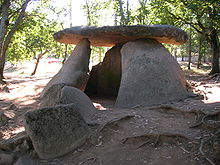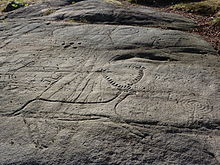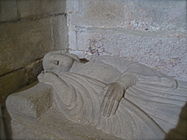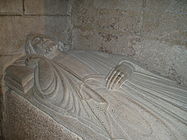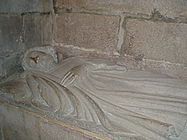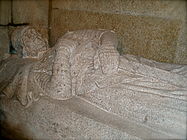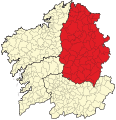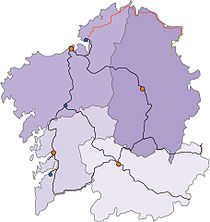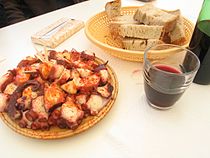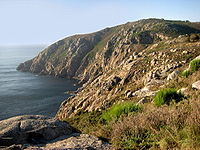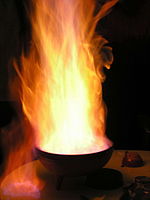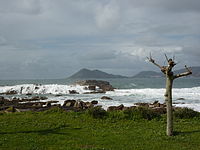- Galicia (Spain)
-
Galicia — Autonomous Community — 
Flag
Coat of armsAnthem: Os Pinos Coordinates: 42°30′N 8°06′W / 42.5°N 8.1°WCoordinates: 42°30′N 8°06′W / 42.5°N 8.1°W Country Spain Capital Santiago de Compostela Provinces A Coruña, Lugo, Ourense, and Pontevedra Government – Type Devolved government in a constitutional monarchy – Body Xunta de Galicia – President Alberto Núñez Feijóo (PPdeG) Area – Total 29,574.4 km2 (11,418.7 sq mi) Area rank 7th (5.8% of Spain) Population (2009) – Total 2,796,089 – Rank 5th (6% of Spain) – Density 94.5/km2 (244.9/sq mi) Demonym Galician
galego (m), galega (f)
gallego (m), gallega (f)Time zone CET (UTC+1) – Summer (DST) CEST (UTC+2) ISO 3166-2 GA Area code +34 98- Statute of Autonomy 1936
28 April 1981Official languages Galician and Spanish Patron saint St. James (Santiago o Maior) Legislature Parliament 75 deputies Congress 25 deputies (out of 350) Senate 19 senators (out of 264) Website Xunta de Galicia Galicia (
 i/ɡəˈlɪsiə/ or /ɡəˈlɪʃə/; Galician: [ɡaˈliθja] or [ħaˈlisja], Spanish: [ɡaˈliθja]) is an autonomous community in northwest Spain, with the official status of a nationality of Spain.[1]
i/ɡəˈlɪsiə/ or /ɡəˈlɪʃə/; Galician: [ɡaˈliθja] or [ħaˈlisja], Spanish: [ɡaˈliθja]) is an autonomous community in northwest Spain, with the official status of a nationality of Spain.[1]Its component provinces are A Coruña, Lugo, Ourense and Pontevedra. It is bordered by Portugal to the south, the Spanish autonomous communities of Castile and León and Asturias to the east, the Atlantic Ocean to the west, and the Bay of Biscay to the north. Besides its continental territory, Galicia includes Arousa Island, and the archipelagos of Cíes, Ons, Sálvora Island, Cortegada Island, Malveiras Islands, Sisargas Islands, and other minor isles and islets.
Galicia has roughly 2.79 million inhabitants as of 2011, with the largest concentration in two coastal areas, from Ferrol to A Coruña in the north-west, and from Vilagarcía to Vigo in the south-west. The capital is Santiago de Compostela, in the province of A Coruña. Vigo, in the province of Pontevedra, is the most populous municipality with 297,332 inhabitants and the second most populous city with 206,411 habitants; while A Coruña is the most populous city with 220,581 habitants and the second most populous municipality with 246,056 habitants in its municipality (INE 2009). Both cities are the cores of the two major metropolitan areas of Galicia.
Two languages are official and widely used in Galicia, Galician, a Romance language which, along with Portuguese, descends from medieval Galician-Portuguese, and Castilian.
Contents
Toponym
The name Galicia derives from the Latin toponym Gallaecia, related to the name of an ancient Celtic tribe that resided north of the Douro river, the Gallaeci or Callaeci in Latin, or Kallaikói (καλλαικoι) in Greek.[2] According to Ptolemy, these Callaeci were the first tribe in the area to battle the invading Romans.[3][4]
The historical denomination Galiza is still used with some frequency, among others by the Galician reintegrationists. It was the most usual Galician spelling of the name of the country during the Low Middle Ages, becoming popular again, in written uses, during the first three quarters of the 20th century; nevertheless, this alternative is now seldom used by the Xunta de Galicia, the local autonomous government. Besides, the Royal Galician Academy, institution responsible for regulating the Galician language, whilst recognizing it as a legitimate denomination had informed that the only official name of the country is Galicia.[5]
Geography
 NASA satellite photo of Galicia
NASA satellite photo of Galicia
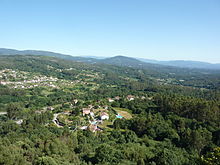 Country view, near Mondariz
Country view, near Mondariz
Galicia has a surface area of 29,574 square kilometres (11,419 sq mi).[6] Its northernmost point, at 43º 47' N, is Estaca de Bares (also the northernmost point of Spain); its southernmost, at 41º 49' N, is on the Portuguese border in the Baixa Limia-Serra do Xurés Natural Park.[6] The easternmost longitude is at 6º 42' W on the border between the province of Ourense and the Castilian-Leonese province of Zamora) its westernmost at 9º 18' W, reached in two places: the La Nave Cape in Fisterra (also known as Finisterre), and Cape Touriñán, both in the province of A Coruña.[6]
Topography
 Carnota, on the Atlantic coast of Galicia
Carnota, on the Atlantic coast of Galicia
 The Ría de Arousa (Pontevedra) has the largest surface area of any of Galicia's rías, or indeed of any in Spain[7]
The Ría de Arousa (Pontevedra) has the largest surface area of any of Galicia's rías, or indeed of any in Spain[7]
The interior of Galicia is a hilly landscape, composed of relatively low mountain ranges, usually below 1,000 m (3,300 ft) high, without sharp peaks, rising to 2,000 m (6,600 ft) in the eastern mountains. There are many rivers, most (though not all) running down relatively gentle slopes in narrow river valleys, though at times their courses become far more rugged, as in the canyons of the Sil river, Galicia's second most important river after the Miño.
Topographically, a remarkable feature of Galicia is the presence of many firth-like inlets along the coast, estuaries that were drowned with rising sea levels after the ice age. These are called rías and are divided into the smaller Rías Altas ("High Rías"), and the larger Rías Baixas ("Low Rías"). The Rías Altas include Ribadeo, Foz, Viveiro, Barqueiro, Ortigueira, Cedeira, Ferrol, Betanzos, A Coruña, Corme e Laxe and Camariñas. The Rías Baixas, found south of Fisterra, include Corcubión, Muros e Noia, Arousa, Pontevedra and Vigo. The Rías Altas can sometimes refer only to those east of Estaca de Bares, with the others being called Rías Medias ("Intermediate Rías").
Erosion by the Atlantic Ocean has contributed to the great number of capes. Besides the aforementioned Estaca de Bares in the far north, separating the Atlantic Ocean from the Cantabrian Sea, other notable capes are Cape Ortegal, Cape Prior, Punta Santo Adrao, Cape Vilán, Cape Touriñán (westernmost point in Galicia), Cape Finisterre or Fisterra, considered by the Romans, along with Finistère in Brittany and Land's End in Cornwall, to be the end of the known world.
All along the Galician coast are various archipelagos near the mouths of the rías. These archipelagos provide protected deepwater harbors and also provide habitat for seagoing birds. A 2007 inventory estimates that the Galician coast has 316 archipelagos, islets, and freestanding rocks.[8] Among the most important of these are the archipelagos of Cíes, Ons, and Sálvora. Together with Cortegada Island, these make up the Atlantic Islands of Galicia National Park. Other significant islands are Islas Malveiras, Islas Sisargas, and, the largest and holding the largest population, Arousa Island.
The coast of this 'green corner' of the Iberian Peninsula, some 1,500 km (930 mi) in length, attracts great numbers of tourists, although real state development in the 2000-2010 decade have degraded it partially.
Mountains
Galicia is quite mountainous, a fact which has contributed to isolate the rural areas, hampering communications, most notably in the inland. The main mountain range is the Macizo Galaico (Serra do Eixe, Serra da Lastra, Serra do Courel), also known as Macizo Galaico-Leonés, located in the eastern parts, bordering with Castile and León. Noteworthy mountain ranges are O Xistral (northern Lugo), the Serra dos Ancares (on the border with León and Asturias), O Courel (on the border with León), O Eixe (the border between Ourense and Zamora), Serra de Queixa (in the center of Ourense province), O Faro (the border between Lugo and Pontevedra), Cova da Serpe (border of Lugo and A Coruña), Montemaior (A Coruña), Montes do Testeiro, Serra do Suído, and Faro de Avión (between Pontevedra and Ourense); and, to the south, A Peneda, O Xurés and O Larouco, all on the border of Ourense and Portugal.
The highest point in Galicia is Trevinca or Pena Trevinca (2124 m, 6969 ft), located in the Serra do Eixe, at the border between Ourense and León and Zamora provinces. Other[9] tall peaks are Pena Survia (2112 m, 6929 ft) in the Serra do Eixe, O Mustallar (1935 m, 6348 ft) in Os Ancares, and Cabeza de Manzaneda (1782 m, 5846 ft) in Serra de Queixa, where there is a ski resort.
Hydrography
Galicia is poetically known as the "country of the thousand rivers" ("o país dos mil ríos"). The largest and most important of these rivers is the Minho, known as O Pai Miño (Father Minho), 307.5 km (191.1 mi) long and discharging 419 m3 (548 cu yd) per second, with its affluent the Sil, which has created a spectacular canyon. Most of the rivers in the inland are tributaries of this fluvial system, which drains some 17,027 km2 (6,574 sq mi). Other rivers run directly into the Atlantic Ocean or the Cantabrian Sea, most of them having short courses. Only the Navia, Ulla, Tambre, and Limia have courses longer than 100 km (62 mi).
Galicia's many hydroelectric dams take advantage of the steep, deep, narrow rivers and their canyons. Few of Galicia's rivers are navigable, other than the lower portion of the Miño and the portions of various rivers that have been dammed into reservoirs. Some rivers are navigable by small boats in their lower reaches: this is taken great advantage of in a number of semi-aquatic festivals and pilgrimages.
Environment
Galicia has preserved some of its dense Atlantic forests, where wildlife is commonly found. It is relatively unpolluted, and its landscapes composed of green hills, cliffs and rias are generally very different from what is commonly understood as Spanish landscape. Nevertheless, Galicia is having some important environmental problems in the modern age. Deforestation and forest fires are a problem in many areas, as it is the continual spread of the eucalyptus tree, an invasive species imported from Australia, actively promoted and researched by the paper industry since the mid-twentieth century. All of this factors are steadily degrading the soils in the coastal, milder areas, and transforming habitats and landscape. Furthermore, excessive hydroelectic development in most rivers have been a serious concern for local conservationist during the last decades.
Fauna, most notably the European Wolf, have suffered because of the actions of livestock owners and farmers, and because of the loss of habitats, whilst the native deer species have declined because of hunting and development.
Recently, oil spills have become a major issue, especially with the Mar Egeo disaster in A Coruña and the Prestige oil spill in 2002, a crude oil spill larger than the Exxon Valdez disaster in Alaska.
Flora
Galicia has more than 2800 plant species. Plant endemics are represented by 31 taxons. Galicia is one of the more wooded areas of Spain, and the majority of Galicia's plantations lack any formal management.[10]
A few oak forests (known locally as fragas) remain, particularly in the north-central part of the province of Lugo and the north of the province of A Coruña (Fragas do Eume). Wood and wood products (particularly softwood pulp) figure significantly in Galicia's economy. There is also some farming, both crops for direct use and pasture for livestock.
Apart from tree plantations, Galicia is also notable for the extensive surface occupied by meadows used for animal husbandry (especially cattle), an important activity.
- Reforestation with eucalyptus (especially Eucalyptus globulus) began in the Francisco Franco era, largely on behalf of the paper company Empresa Nacional de Celulosas de España (ENCE) in Pontevedra, which wanted it for its pulp.
Fauna
Galicia has 262 inventoried species of vertebrates, including 12 species of freshwater fish, 15 amphibians, 24 reptiles, 152 birds and 59 mammals.[11]
The animals most often thought of as being "typical" of Galicia are the livestock raised there. The Galician Pony is native to the region, as is the Galician Blond cow and the domestic fowl known as the galiña de Mos. The latter is an endangered species, although it is showing signs of a comeback since 2001.[12]
Galicia's woodlands and mountains are home to rabbits, hares, wild boars and roe deer, all of which are popular with hunters.
Several important bird migration routes pass through Galicia, and some of the community's relatively few environmentally protected areas are Special Protection Areas (such as on the Ría de Ribadeo) for these birds.
From a domestic point of view, Galicia has been credited for author Manuel Rivas as the "land of one million cows". Galician Blond and Holstein cattle coexist on meadows and farms.
Climate
The lands of Galicia are ascribed to two different areas in the Köppen climate classification: a south-east area (roughly, the province of Ourense) with tendencies to have some summer drought, classified as a warm-summer Mediterranean climate (Csb), similar to the climate of the coastal regions of Oregon and Washington, with mild temperatures and rainfall usual throughout the year; and the western and northern coastal regions, the provinces of Lugo, A Coruña, and Pontevedra, which are characterized by their Oceanic climate (Csf), with a more uniform precipitation distribution along the year, and milder summers.[13]
As an example, Santiago de Compostela, the capital city, has an average[14] of 129 rainy days and 1,362 millimetres (53.6 in) per year (with just 17 rainy days in the three summer months) and 2,101 sunlight hours per year, with just 6 days with frosts per year. But the colder city of Lugo, to the east, has an average of 1,759 sunlight hours per year,[15] 117 days with precipitations (> 1 mm) totalling 901.54 millimetres (35.5 in), and 40 days with frosts per year. The more mountainous parts of the provinces of Ourense and Lugo receive significant snowfall during the winter months.
Climate data for some locations in Galicia (average 2006-2010):[16]
City/Town Hottest month av. Coldest month av. Precipitations Days with precip. Days with p. (summer) Days with frost Sunlight hours Santiago de Compostela 19.1 °C (66.4 °F) 7.4 °C (45.3 °F) 1,362 millimetres (53.6 in) 129 17 6 2,101 Santa Comba 17.6 °C (63.7 °F) 7.3 °C (45.1 °F) 1,983 millimetres (78.1 in) 144 21 8 2,064 Ferrol 20.0 °C (68.0 °F) 9.6 °C (49.3 °F) 1,304 millimetres (51.3 in) 138 19 1 2,147 Lugo 18.6 °C (65.5 °F) 5.1 °C (41.2 °F) 902 millimetres (35.5 in) 117 12 40 1,759 Ribadeo 19.0 °C (66.2 °F) 9.0 °C (48.2 °F) 1,093 millimetres (43.0 in) 124 18 1 1,823 Ourense 22.0 °C (71.6 °F) 6.9 °C (44.4 °F) 833 millimetres (32.8 in) 95 9 17 1,909 Pontevedra 20.2 °C (68.4 °F) 8.6 °C (47.5 °F) 1,487 millimetres (58.5 in) 126 14 7 2,169 History
Main article: History of GaliciaHistory of Galicia 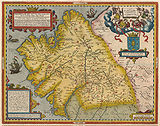
This article is part of a seriesPrehistoric Galicia Gallaeci (Celtic tribe) Roman Gallaecia Suebi Kingdom Brythonic Galicia Kingdom of Galicia Compostelan Era Galician Modern Age Galicia in the 20th century Galicia at Present
Galicia Portal
Prehistory
See also: Atlantic Bronze AgeThe Eirós Cave in the municipality of Triacastela (province of Lugo) has preserved animal remains and Neanderthal stone objects from the Middle Paleolithic, thanks to its alkaline soils. There are other remnants of the Middle Paleolithic along the lower Miño and in the Ourense depression.
The earliest culture to have left significant architectural traces is the Megalithic culture which expanded along the western European coasts during the Neolithic and Calcolithic eras. Thousands of Megalithic tumuli[17] are distributed all along the country. Within each tumulus is a stone burial chamber known locally as anta (dolmen), many of them preceded by a corridor; the sizes of these chambers vary.
Rich mineral deposits led to the development of Bronze Age metallurgy. Utensils and gold and bronze jewelry from Galicia have been found as far away as the far side of the Pyrenees, while Atlantic Bronze Age commerce created an extensive network which expanded a common elite culture all along the Atlantic fringe of Europe.
At this time, climate change seems to have driven migration into the region from the vast plateau of Iberia's Meseta Central,[citation needed] increasing the population and causing conflict between communities. Before the Roman invasion, a series of tribes lived in the region (Gallaeci, Celtici), and according to Pomponius Mela, Strabo, Pliny, Herodotus and others, they shared similar Celtic customs.
Castro culture
 Reconstruction of a group of huts of the Castro culture
Reconstruction of a group of huts of the Castro culture Rock carvings, Laxe dos carballos, Campo Lameiro
Rock carvings, Laxe dos carballos, Campo Lameiro Main articles: Castro Culture and Gallaeci
Main articles: Castro Culture and GallaeciThe Castro culture[18] ('Culture of the Castles') flourished in the second half of the first millennium BCE, being usually considered a local evolution of the Atlantic Bronze Age culture, with later developments and influences, and overlapping into the Roman era. Geographically, it corresponds to the people Roman called Gallaeci. They were capable fighters; Strabo described them as the most difficult foes the Romans encountered in conquering Lusitania, while Appian[19] mentions their warlike spirit, noting that the women bore their weapons side by side with their mens, frequently preferring death to captivity.
The castros date from this era. These were usually annular forts, with one or more concentric earthen or stony walls, with a trench in front of each one. They were located at hills, or in seashore cliffs and peninsulas. Some visitable castros can be found, in the seashore, at Fazouro, Santa Tegra, Baroña and O Neixón, and inland at San Cibrao de Lás, Borneiro, Castromao, and Viladonga.
Some other distinct features, such as temples, baths, reservoirs, warrior statues and decorative carvings, have been found associated to this culture. In some of the walls and at other places, human and animal remains have been found, probably as part of a founding, protective ritual.
Dating from the end of the Megalithic era, and up to the Bronze Age, there are numerous stone carvings (petroglyphs) in open air, being their significance unknown.[20] The best known of these are at Campo Lameiro.
Castro Culture Celtic castro of Viladonga, province of LugoA selection of motifs and carvings of the Castro cultureMonumental gate of the oppidum of San Cibrao de Lás, near OurenseRoman rule
The Roman legions first entered the area under Decimus Junius Brutus in 137–136 BC,[21] but the country was only incorporated into the Roman Empire by the time of Augustus. The Romans were interested in Galicia mainly for its mineral resources, most notably gold. Under Roman rule, most castros were abandoned, and Galicians served frequently in the Roman army.
The Romans brought new technologies, new travel routes, new forms of organizing property, and a new language, building roads and monuments as the lighthouse known as Torre de Hércules, in A Coruña, but the remoteness and lesser interest of the country since the 2nd century of our era, led to a lower degree of Romanization when compared to other areas, hindering and delaying the introduction of Christianity.
In the 3rd century it was made a province, under the name Gallaecia, which included also northern Portugal, Asturias, and a large section of what today is known as Castilla y León.
Middle Ages
 Illustration from a Cantigas de Santa Maria manuscript
Illustration from a Cantigas de Santa Maria manuscript Main articles: Suevic Kingdom of Galicia and Kingdom of GaliciaSee also: Galician Language
Main articles: Suevic Kingdom of Galicia and Kingdom of GaliciaSee also: Galician LanguageDuring the Migration Period, in the 5th century, Galicia was taken by the Suevi in 409, forming the first medieval kingdom to be created in Europe, in 411, even before the fall of the Roman Empire, being also the first Germanic kingdom to mint coinage in Roman lands. During this period a Briton colony and bishopric (see Mailoc) was established in Northern Galicia (Britonia), probably as foederati and allies of the Suevi. In 585, the Visigothic King Leovigild invaded the Suebic kingdom of Galicia and defeated it, bringing it under Visigoth control.
Later the Muslims invaded Spain (711), but the Arabs and Moors never managed to have any real control over Galicia, which was later incorporated into the expanding Christian Kingdom of Asturias, usually known as Gallaecia or Galicia (Yillīqiya and Galīsiya) by Muslim Chroniclers,[22] as well as by many European contemporaries.[23] This era consolidated Galicia as a Christian society which spoke a Romance language. During the next century Galician noblemen took northern Portugal, conquering Coimbra in 871, thus freeing what were considered the southernmost city of ancient Galicia.
In the 9th century, the rise of the cult of the Apostle James in Santiago de Compostela gave Galicia a particular symbolic importance among Christians, an importance it would hold throughout the Reconquista. As the Middle Ages went on, Santiago became a major pilgrim destination and the Way of Saint James a major pilgrim road, a route for the propagation of Romanesque art and the words and music of the troubadors. During the 10th and 11th centuries, a period during which Galician nobility become related to the royal family, Galicia was at times headed by its own privative kings, whilst Vikings (locally know as Leodemanes or Lordomanes) occasionally raided the coasts. The Towers of Catoira[24] (Pontevedra) were built as a system of fortifications to prevent and stop the Viking raids on Santiago de Compostela.
In 1063, Ferdinand I of Castile divided his realm among his sons, and the Kingdom of Galicia was granted to Garcia II of Galicia. In 1072, it was forcibly annexed by Garcia's brother Alfonso VI of León; from that time Galicia was united with the Kingdom of León under the same monarchs. In the 13th century Alfonso X of Castile standardized the Castilian language and made it the language of court and government. Nevertheless, in his Kingdom of Galicia the Galician language was the only language spoken, and the most used in government and legal uses, as well as in literature.
Royal pantheon of the Cathedral of Santiago de Compostela Sepulcher of count Raymond of Burgundy, lord of Galicia (d. 1107)Sepulcher of king Ferdinand II of León and Galicia (d. 1187)Sepulcher of king Alfonso IX of León and Galicia (d. 1230)Sepulcher of count Pedro Fróilaz de Traba, protector of king Alfonso VII (d. 1128)Modern era
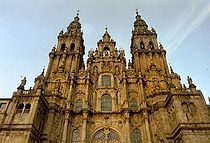 The Cathedral of Santiago de Compostela. The western facade, shown here, dates largely from the 18th century, although the low towers at the corners date back to the Middle Ages
The Cathedral of Santiago de Compostela. The western facade, shown here, dates largely from the 18th century, although the low towers at the corners date back to the Middle Ages
In the dynastic conflict between Isabella I of Castile and Joanna La Beltraneja, who was believed to be the illegitimate daughter of Beltrán and the former queen, most of the Galician aristocracy supported Joanna. After Isabella's victory, she initiated the "Doma y Castración del Reino de Galicia", that is, the "Taming and Castration of the Kingdom of Galicia" (Court Historian, Zurita), a process of centralisation.
In the face of this development, the Galician language began a slow decline that would culminate in the Séculos Escuros ("Obscure Centuries"), roughly the 16th through mid-18th centuries, when written Galician practically disappeared, and the language survived only orally, marginalizing Galician-speakers.
During the Peninsular War, Galicia was one of the most affected areas. However, organisation between local people and the British Army led to a very short six-month period of French control.
The 1833 territorial division of Spain put a formal end to the Kingdom of Galicia, unifying Spain into a single centralized monarchy. Instead of seven provinces and a regional administration, Galicia was reorganized into the current four provinces. Although it was recognized as a "historical region", that status was strictly honorific. In reaction, nationalist and federalist movements arose.
The liberal General Miguel Solís Cuetos led a separatist coup attempt in 1846 against the authoritarian regime of Ramón María Narváez. Solís and his forces were defeated at the Battle of Cacheiras, 23 April 1846, and the survivors, including Solís himself, were shot. They have taken their place in Galician memory as the Martyrs of Carral or simply the Martyrs of Liberty.
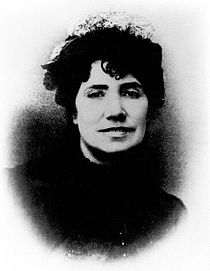 Rosalía de Castro: her poetry book Cantares gallegos marked the start of the Rexurdimento
Rosalía de Castro: her poetry book Cantares gallegos marked the start of the Rexurdimento
Defeated on the military front, Galicians turned to culture. The Rexurdimento focused on recovery of the Galician language as a vehicle of social and cultural expression. Among the writers associated with this movement are Rosalía de Castro, Manuel Murguía, Manuel Leiras Pulpeiro, and Eduardo Pondal.
In the early 20th century came another turn toward nationalist politics with Solidaridad Gallega (1907–1912) modeled on Solidaritat Catalana in Catalonia. Solidaridad Gallega failed, but in 1916 Irmandades da Fala (Brotherhood of the Language) developed first as a cultural association but soon as a full-blown nationalist movement. Vicente Risco and Ramón Otero Pedrayo were outstanding cultural figures of this movement, and the magazine Nós ('Us'), founded 1920, its most notable cultural institution; Lois Peña Novo the outstanding political figure.
The Second Spanish Republic was declared in 1931. During the republic, the Partido Galeguista (PG) was the most important of a shifting collection of Galician nationalist parties. Following a referendum on a Galician Statute of Autonomy, Galicia was granted the status of an autonomous region, starting the path for the constitution of a Galician state into a Spanish federal republic. However, because of the Spanish Civil War, this was never put into practice.
Galicia was spared the worst of the fighting in that war. It was one of the areas where the initial coup attempt at the outset of the war was successful, and it remained in Nationalist (Franco's army) hands throughout the war. While there were no pitched battles, there was repression and even death: all political parties were abolished, as were all labor unions and Galician nationalist organizations. Galicia's statute of autonomy was annulled (as were those of Catalonia and the Basque provinces once those were conquered). According to Carlos Fernández Santander, at least 4,200 people were killed either extrajudicially or after summary trials. Victims included the civil governors of all four Galician provinces; Juana Capdevielle, the wife of the governor of La Coruña; mayors such as Ángel Casal of Santiago de Compostela; prominent socialists such as Jaime Quintanilla in Ferrol and Emilio Martínez Garrido in Vigo; Popular Front deputies Antonio Bilbatúa, José Miñones, Díaz Villamil, Ignacio Seoane, and former deputy Heraclio Botana); soldiers who had not joined the rebellion, such as Generals Rogelio Caridad Pita and Enrique Salcedo Molinuevo and Admiral Antonio Azarola; and the founders of the PG, Alexandre Bóveda and Víctor Casas.[25] Many others managed to escape into exile.
General Francisco Franco — himself a Galician from Ferrol — ruled as dictator from the civil war until his death in 1975. Franco's centralizing regime suppressed any official promotion of the Galician language, although its everyday use was never proscribed. Among the attempts at resistance were small leftist guerrilla groups such as those led by José Castro Veiga ("El Piloto") and Benigno Andrade ("Foucellas"), both of whom were ultimately captured and executed.[26][27] In the 1960s, ministers such as Manuel Fraga Iribarne introduced some reforms allowing technocrats affiliated with Opus Dei to modernize administration in a way that facilitated capitalist economic development. However, for decades Galicia was largely confined to the role of a supplier of raw materials and energy to the rest of Spain, causing environmental havoc and leading to a wave of migration to Venezuela and to various parts of Europe. Fenosa, the monopolistic supplier of electricity, built hydroelectric dams, flooding many Galician river valleys.
The Galician economy finally began to modernize with a Citroën factory in Vigo, the modernization of the canning industry and the fishing fleet, and eventually a modernization of small peasant farming practices, especially in the production of cows' milk. In the province of Ourense, businessman and politician Eulogio Gómez Franqueira gave impetus to the raising of livestock and poultry by establishing the Cooperativa Orensana S.A. (Coren).
During the last decade of Franco's rule, there was a renewal of nationalist feeling in Galicia. The early 1970s were a time of unrest among university students, workers, and farmers. In 1972, general strikes in Vigo and Ferrol cost the lives of Amador Rey and Daniel Niebla.[28] That same year, the bishop of Mondoñedo-Ferrol, Miguel Anxo Araúxo Iglesias, wrote a pastoral letter that was not well received by the Franco regime, about a demonstration in Bazán (Ferrol) where two workers died.[29]
As part of the transition to democracy upon the death of Franco in 1975, Galicia regained its status as an autonomous region within Spain with the Statute of Autonomy of 1981, which begins, "Galicia, historical nationality, is constituted as an Autonomous Community to access to its self-government, in agreement with the Spanish Constitution and with the present Statute (...)". Varying degrees of nationalist or independentist sentiment are evident at the political level. The only nationalist party of any electoral significance, the Bloque Nacionalista Galego or BNG, is a conglomerate of left-wing parties and individuals that claims Galician political status as a nation.
From 1990 to 2005, Manuel Fraga, former minister and ambassador in the Franco dictature, presided over the Galician autonomous government, the Xunta de Galicia. Fraga was associated with the Partido Popular ('People's Party', Spain's main national conservative party) since its founding. In 2002, when the oil tanker Prestige sank and covered the Galician coast in oil, Fraga was accused by the grassroots movement Nunca Mais ("Never again") of having been unwilling to react. In the 2005 Galician elections, the 'People's Party' lost its absolute majority, though remaining (barely) the largest party in the parliament, with 43% of the total votes. As a result, power passed to a coalition] of the Partido dos Socialistas de Galicia (PSdeG) ('Galician Socialists' Party'), a federal sister-party of Spain's main social-democratic party, the Partido Socialista Obrero Español (PSOE, 'Spanish Socialist Workers Party') and the nationalist Bloque Nacionalista Galego (BNG). As the senior partner in the new coalition, the PSdeG nominated its leader, Emilio Perez Touriño, to serve as Galicia's new president, with Anxo Quintana, the leader of BNG, as its vice-president.
In 2009 the PSdG-BNG coalition lost the elections and the government went back to the People's Party (conservative), which will govern until 2013. Alberto Núñez Feijóo (PP) is now Galicia's president. It must be said that the PSdG-BNG coalition actually obtained the most of votes.
Language
Main article: Galician languagePercentage of Galician-speakers by municipality, according to the Instituto Gallego de Estadística, 2001. In general, the percentage is lowest in the urban areas
Galicia has two official languages: Galician (Galician: galego) and Spanish (known in Spain as castellano, "Castilian"), both of them Romance languages, the former originated locally, the latter born in Castile. Galician is recognized in the Statute of Autonomy of Galicia as the lingua propia ("own language") of Galicia.
Galician is closely related to Portuguese. Both share a common medieval phase known as Galician-Portuguese.[30] The independence of Portugal since the late Middle Ages has favored the divergence of the Galician and Portuguese languages.[31]
The official Galician language has been standardized by the Real Academia Galega on the basis of literary tradition. Although there are local dialects, Galician media conform to this standard form, which is also used in primary, secondary, and university education. There are more than three million Galician speakers in the world,[31] placing Galician just barely among the 150 most widely spoken languages on earth.[6]
Spanish was nonetheless the only official language in Galicia for more than four centuries. Over the many centuries of Castilian domination, Galician faded from day-to-day use in urban areas. The period since the re-establishment of democracy in Spain—in particular since the Ley de Normalización Lingüística ("Law of Linguistic Normalization", Ley 3/1983, 15 June 1983)—represents the first time since the introduction of mass education that a generation has attended school in Galician (Spanish is also still taught in Galician schools).
Nowadays, Galician is resurgent, though in the cities it remains a "second language" for most. According to a 2001 census, 99.16 percent of the populace of Galicia understand the language, 91.04 percent speak it, 68.65 percent read it and 57.64 percent write it.[32] The first two numbers (understanding and speaking) remain roughly the same as a decade earlier; the latter two (reading and writing) both show enormous gains: a decade earlier, only 49.3 percent of the population could read Galician, and only 34.85 percent could write it. This fact can be easily explained because of the impossibility of teaching Galician during the Francisco Franco era, so older people speak the language but have no written competence.[32] Galician is the highest-percentage spoken language in its region among the regional languages of Spain.
The earliest known document in Galician-Portuguese dates from 1228. The Foro do bo burgo do Castro Caldelas was granted by Alfonso IX of Castile to the Ourensian town of Allariz.[33] A distinct Galician Literature emerged after the Middle Ages. In the 13th century, important contributions were made to the romance canon in Galician-Portuguese. The most notable were by the troubadour Martín Codax, by King Denis of Portugal and by King Alfonso X of Castile, Alfonso O Sabio ("Alfonso the Wise"), the same monarch who began the process of establishing the hegemony of Castilian. During this period, Galician-Portuguese was considered the language of love poetry in the Iberian Romance linguistic culture. The names and memories of Codax and other popular cultural figures are well preserved in modern Galicia and, despite the long period of Castilian linguistic domination, these names are again household words.
Government and politics
Regional government
Galicia 
This article is part of the series:
Politics and government of
GaliciaExecutive- Xunta de Galicia
- President
- Vice President
- Cabinet
Legislature- Parliament
- President
Elections- Political parties
- Last election
Divisions- National
- Regional
- Comarcas
- Municipalities
Galicia has partial self-governance, in the form of a devolved government, established on 16 March 1978 and reinforced by the Galician Statute of Autonomy, ratified on 28 April 1981. There are three branches of government: the executive branch, the Xunta de Galicia, consisting of the President and the other independently elected councillors;[34] the legislative branch consisting of the Galician Parliament; and the judicial branch consisting of the High Court of Galicia and lower courts.
Executive
Main article: Xunta de GaliciaThe Xunta de Galicia is a collective entity with executive and administrative power. It consists of the President, a vice president, and twelve councillors. Administrative power is largely delegated to dependent bodies. The Xunta also coordinates the activities of the provincial councils (Galician: deputacions).
The President of the Xunta directs and coordinates the actions of the Xunta. He or she is simultaneously the representative of the autonomous community and of the Spanish state in Galicia. He or she is a member of the parliament and is elected by its deputies and then formally named by the monarch of Spain.
Legislative
Main article: Parliament of GaliciaThe Galician Parliament[35] consists of 75 deputies elected by universal adult suffrage under a system of proportional representation. The franchise includes even Galicians who reside abroad. Elections occur every four years.
The last election of 2 May 2009 resulted in the following distribution of seats:
- Partido Popular de Galicia (PPdeG): 38 deputies (47.11%)
- Partido Socialista de Galicia (PSdeG-PSOE): 25 deputies (29.92%)
- Bloque Nacionalista Galego (BNG): 12 deputies (16.58%)
Judicial
Main article: High Court of GaliciaLocal government
There are 315 municipalities (Galician: municipios) in Galicia, each of which is run by a mayor-council government known as a concello.
There is a further subdivision of local government known as an Entidade local menor; each has its own council (xunta vecinal) and mayor (alcalde da aldea). There are nine of these in Galicia: Arcos da Condesa, Bembrive, Camposancos, Chenlo, Morgadans, Pazos de Reis, Queimadelos, Vilasobroso and Beran.
National government
Galicia's interests are represented at national level by 25 elected deputies in the Congress of Deputies and 19 senators in the Senate - of these, 16 are elected and 3 are appointed by the Galician parliament.
Administrative divisions
Prior to the 1833 territorial division of Spain Galicia was divided into seven administrative provinces:[36]
From 1833, the seven original provinces of the 15th century were consolidated into four:
- Provinces of Galicia (location maps)
Galicia is further divided into 53 comarcas, 315 municipalities and 3,778 parishes. Municipalities are divided into parishes, which may be further divided into aldeas ("hamlets") or lugares ("places"). This traditional breakdown into such small areas is unusual when compared to the rest of Spain. Roughly half of the named population entities of Spain are in Galicia, which occupies only 5.8 percent of the country's area. It is estimated that Galicia has over a million named places, over 40,000 of them being communities.[37]
Public services
Health care
Main article: Servizo Galego de SaúdeGalicia's public healthcare system is the Servizo Galego de Saúde (SERGAS). It is administered by the regional government's Ministry of Health.
Education
Galicia's education system is administered by the regional government's Ministry of Education and University Administration. 76% of Galician teenagers achieve a high school degree - ranked fifth out of the 17 autonomous communities.
There are three public universities in Galicia: University of A Coruña, University of Santiago de Compostela and the University of Vigo.
Economy
Main article: Economy of GaliciaIn comparison to the other regions of Spain, the major economic benefit of Galicia is its fishing Industry. Galicia is a land of economic contrast. While the western coast, with its major population centers and its fishing and manufacturing industries, is prosperous and increasing in population, the rural hinterland — the provinces of Ourense and Lugo — are economically dependent on traditional agriculture, based on small landholdings called minifundios. However, the rise of tourism, sustainable forestry and organic and traditional agriculture are bringing other possibilities to the Galician economy without compromising the preservation of the natural resources and the local culture.
Traditionally, Galicia depended mainly on agriculture and fishing. Reflecting that history, the Community Fisheries Control Agency, which coordinates fishing controls in European Union waters is based in Vigo. Nonetheless, today the tertiary sector of the economy (the service sector) is the largest, with 582,000 workers out of a regional total of 1,072,000 (as of 2002).
The secondary sector (manufacturing) includes shipbuilding in Vigo and Ferrol, textiles and granite work in A Coruña. A Coruña also manufactures automobiles, but not nearly on the scale of the automobile manufacturing in Vigo. The Centro de Vigo de PSA Peugeot Citroën, founded in 1958, makes about 450,000 vehicles annually (455,430 in 2006);[38] a Citroën C4 Picasso made in 2007 was their nine-millionth vehicle.[39]
Arteixo, an industrial municipality in the A Coruña metropolitan area, is the headquarters of Inditex, Europe's largest textile company and the world's second largest. Of their eight brands, Zara is the best-known; indeed, it is the best-known Spanish brand of any sort on an international basis.[40] For 2007, Inditex had 9,435 million euros in sales for a net profit of 1,250 million euros.[41] The company president, Amancio Ortega, is the richest person in Spain[42] with a net worth of 21.5 billion euros.[43]
Galicia is home to the savings bank Novacaixagalicia, and to Spain's two oldest commercial banks Banco Etcheverría (the oldest) and Banco Pastor.
Galicia was late to catch the tourism boom that has swept Spain in recent decades, but the coastal regions (especially the Rías Baixas and Santiago de Compostela) are now significant tourist destinations. In 2007, 5.7 million tourists visited Galicia, an 8 percent growth over the previous year, and part of a continual pattern of growth in this sector.[44] 85 percent of touristas who visit Galicia visit Santiago de Compostela.[44] Tourism constitutes 12 percent of the Galician GDP and employs between 12 and 13 percent of the regional workforce.[44]
Demographics
Population
Galicia's inhabitants are known as Galicians (Galician: galegos, Spanish: gallegos). For well over a century Galicia has grown more slowly than the rest of Spain, due largely to emigration to Latin America and to other parts of Spain. Sometimes Galicia has lost population in absolute terms. In 1857, Galicia had Spain's densest population and constituted 11.49 percent of the national population. As of 2007, only 6.13 percent of the Spanish population resides in the autonomous community. This is due to the diaspora galician people was forced to since the nineteenth century, first to South America and later to Central Europe.
According to the 2006 census, Galicia has a fertility rate of 1.03 children per woman, compared to 1.38 nationally, and far below the figure of 2.1 that represents a stable populace.[45] Lugo and Ourense provinces have the lowest fertility rates in Spain, 0.88 and 0.93, respectively.[45]
Within the region, the A Coruña-Ferrol metropolitan area has become increasingly dominant in terms of population. The population of the city of A Coruña in 1900 was 43,971. The population of the rest of the province including the City and Naval Station of nearby Ferrol and Santiago de Compostela was 653,556. A Coruña's growth occurred after the Spanish Civil War at the same speed as other major Galician cities, but it was the arrival of democracy in Spain after the death of Francisco Franco when A Coruña left all the other Galician cities behind.
The rapid increase of population of Vigo, A Coruña, and to a lesser degree Santiago de Compostela and other major Galician cities, during the years that followed the Spanish Civil War during the mid 20th century occurred as the rural population declined: many villages and hamlets of the four provinces of Galicia disappeared or nearly disappeared during the same period. Economic development and mechanization of agriculture resulted in the fields being abandoned, and most of the population has moving to find jobs in the main cities. The number of people working in the Tertiary and Quaternary sectors of the economy has increased significantly.
Since 1999, the absolute number of births in Galicia has been increasing. In 2006, 21,392 births were registered in Galicia,[46] 300 more than in 2005, according to the Instituto Galego de Estadística. Since 1981, the Galician life expectancy has increased by 5 years, thanks to a higher quality of life.[47][48]
- Birth rate (2006): 7.9 per 1,000 (all of Spain: 11.0 per 1,000)
- Death rate (2006): 10.8 per 1,000 (all of Spain: 8.4 per 1,000)
- Life expectancy at birth (2005): 80.4 years (all of Spain: 80.2 years)
- Male: 76.8 years (all of Spain: 77.0 years)
- Female: 84.0 years (all of Spain: 83.5 years)
Urbanization
The principal cities are Vigo, A Coruña, Ourense, Lugo, Pontevedra, Ferrol and Santiago de Compostela, the capital and archiepiscopal seat.
The largest conurbations are:
- A Coruña-Ferrol – 640,000
- Vigo-Pontevedra – 660,000
List of towns in Galicia by population City/Town Province Population (2009) City/Town Province Population (2009) 1 Vigo Pontevedra 297,332 11 Carballo A Coruña 30,990 2 A Coruña A Coruña 246,056 12 Redondela Pontevedra 30,001 3 Ourense Ourense 107,742 13 Arteixo A Coruña 29,762 4 Lugo Lugo 96,678 14 Culleredo A Coruña 28,227 5 Santiago de Compostela A Coruña 95,092 15 Ribeira A Coruña 27,518 6 Pontevedra Pontevedra 81,576 16 Ames A Coruña 26,983 7 Ferrol A Coruña 74,273 17 Marín Pontevedra 25,969 8 Narón A Coruña 37,712 18 Cangas de Morrazo Pontevedra 25,748 9 Vilagarcía de Arousa Pontevedra 37,576 19 Cambre A Coruña 23,231 10 Oleiros A Coruña 33,443 20 Ponteareas Pontevedra 23,172 Migration
Like most of Western Europe, Galicia's history has been defined by mass emigration. There was significant Galician emigration in the late 19th and early 20th centuries to the industrialized Spanish cities of Barcelona, Bilbao, Zaragoza and Madrid and to Latin America - Argentina, Uruguay, Venezuela, Brazil and Cuba in particular. One notable example of that emigration is that of Fidel Castro, whose father was a Galician immigrant and mother was of Galician descent.
The two cities with the greatest number of people of Galician descent outside of Galicia itself are Buenos Aires, Argentina, and nearby Montevideo, Uruguay, where immigration from Galicia was so significant that Argentines and Uruguayans now commonly refer to all Spaniards as gallegos (Galicians).[49]
During the Franco years there was a new wave of emigration out of Galicia to other European countries, most notably to France, Germany, Switzerland, and the United Kingdom. There are many expatriate communities throughout the world, and many have their own groups or clubs. Galician immigration is so widespread that websites such as Fillos de Galicia were created in order to organize and inform Galicians throughout the world.
The proportion of foreign-born people in Galicia is only 2.9 percent compared to a national figure of 10 percent; among the autonomous communities, only Extremadura has a lower percentage of immigrants.[50] Of the foreign nationals resident in Galicia, 17.93 percent are ethnically related Portuguese, 10.93 percent are Colombian and 8.74 percent Brazilian.[6]
Transportation
Airports
 Control tower, Santiago de Compostela Airport
Control tower, Santiago de Compostela Airport
Galicia's principal airport is the Santiago de Compostela Airport, the only Galician airport with intercontinental flights. With 1,943,900 passengers in 2009, it connects to cities in Spain as well as several major European cities – a scheduled transcontinental service to Caracas and Buenos Aires has been proposed. There are two other commercial-aviation airports in Galicia: Vigo-Peinador Airport which in 2008 had 1,278,762 passengers, it connects to cities in Spain and to London, Paris, and Brussels. A Coruña Airport had 1,174,970 passengers in 2008; it connects around Spain, to Lisbon, Amsterdam, Paris and a highly flown line to London.
Ports
The most important Galician port is the Port of Vigo; It is one of the world's leading fishing ports, second only to Tokyo, with an annual catch worth 1,500 million euros.[51][52] In 2007 the port took in 732,951 metric tons (721,375 long tons; 807,940 short tons) of fish and seafood, and about 4,000,000 metric tons (3,900,000 long tons; 4,400,000 short tons) of other cargoes. Other important ports are Ferrol, A Coruña, and the smaller ports of Marín and Vilagarcía de Arousa, as well as important recreational ports in Pontevedra and Burela. Beyond these, Galicia has 120 other organized ports.
Roads
The Galician road network includes autopistas and autovías connecting the major cities, as well as national and secondary roads to the rest of the municipalities. The Autovía A-6 connects A Coruña and Lugo to Madrid, entering Galicia at Pedrafita do Cebreiro. The Autovía A-52 connects Vigo, Ourense and Benavente, and enters Galicia at A Gudiña. Two more autovías are under construction. Autovía A-8 enters Galicia on the Cantabrian coast, and ends in Baamonde (Lugo province). Autovía A-76 enters Galicia in Valdeorras; it is an upgrade of the existing N-120 to Ourense and Vigo.
Within Galicia are the Autopista AP-9 from Ferrol to Vigo and the Autopista AP-53 (also known as AG-53, because it was initially built by the Xunta de Galicia) from Santiago to Ourense. Additional roads under construction include Autovía A-54 from Santiago de Compostela to Lugo, and Autovía A-56 from Lugo to Ourense. The Xunta de Galicia has built roads connecting comarcal capitals, such as the aforementioned AG-53, or Autovía AG-55 connecting A Coruña to Carballo.
Railways
The first railway line in Galicia was inaugurated 15 September 1873. It ran from O Carril, Vilagarcía de Arousa to Cornes, Conxo, Santiago de Compostela. A second line was inaugurated in 1875, connecting A Coruña and Lugo. In 1883, Galicia was first connected by rail to the rest of Spain, by way of O Barco de Valdeorras.
Galicia today has roughly 1,100 kilometres (680 mi) of rail lines. Several Iberian gauge (1,668 mm) lines operated by Adif and Renfe Operadora connect all the important Galician cities. A metre gauge (1,000 mm) line operated by FEVE connects Ferrol to Ribadeo and Oviedo. The only electrified line is the Ponferrada-Monforte de Lemos-Ourense-Vigo line.
Several AVE high speed train lines are under construction. Among these are the Olmedo-Zamora-Galicia scheduled to open in 2012, which will connect Santiago and Ourense to Madrid, and the AVE Atlantic Axis route, which will connect all of the major Galician Atlantic coast cities to Portugal. Other projected AVE lines are Vigo-Monforte and A Coruña-León.
Culture
Literature
Medieval Galician poetryWhat dear delight this summer day,
Its trees and flowers, to me doth bring,
And birds that songs of love here sing,
For joyfully without care
I go, ev'n as all lovers fare,
Who gay and merry are alway.
And when I pass by streams that wind
Beneath fair trees, through meadows fair,
It their love-song the birds say there,
Then all in love I sing straightaway,
And there of love compose my lay
And love-songs make in many a kind.
Great joy and mirth with me abide
When birds sing in sweet summertide.Joan Airas (13th century),
translation by Aubrey F. G. BellAs with many other Romance languages, Galician-Portuguese emerged as a literary language in the Middle Ages, during the 12th-13th century, when a rich lyric tradition developed. However, in the face of the hegemony of Castilian Spanish, during the so-called Séculos Escuros ("Dark Centuries"), from 1530 to 1800, it fell from major literary or legal use, revived again during the 19th century Rexurdimento with such writers as Rosalía de Castro, Manuel Murguía, Manuel Leiras Pulpeiro, and Eduardo Pondal. In the 20th century, before the Spanish Civil War the Irmandades da Fala ("Brotherhood of the Language") and Grupo Nós included such writers as Vicente Risco, Ramón Cabanillas and Castelao. Public use of Galician was largely suppressed during the Franco dictatorship but has been resurgent since the restoration of democracy. Contemporary writers in Galician include Xosé Luís Méndez Ferrín, Manuel Rivas, and Suso de Toro.
Cuisine
Main article: Galician cuisine Wines of Galicia with Denominación de Origen
Wines of Galicia with Denominación de Origen
Galician cuisine often uses fish and shellfish. The empanada is a meat or fish pie, with a bread-like base, top and crust with the meat or fish filling usually being in a tomato sauce including onions and garlic. Caldo galego is a hearty soup whose main ingredients are potatoes and a local vegetable named grelo (Broccoli rabe). The latter is also employed in Lacón con grelos, a typical carnival dish, consisting of pork shoulder boiled with grelos, potatoes and chorizo. Centolla is the equivalent of King Crab. It is prepared by being boiled alive, having its main body opened like a shell, and then having its innards mixed vigorously. Another popular dish is octopus, boiled (traditionally in a copper pot) and served in a wooden plate, cut into small pieces and laced with olive oil, sea salt and pimentón (Spanish paprika). This dish is called Pulpo a la gallega or in Galician "Polbo á Feira", which roughly translates as "Galician-style Octopus". There are several regional varieties of cheese. The best known one is the so-called tetilla, named after its breast-like shape. Other highly regarded varieties include the San Simón cheese from Vilalba and the creamy cheese produced in the Arzúa-Curtis area. The latter area produces also high-quality beef. A classical dessert is filloas, crêpe-like pancakes made with flour, broth and eggs. When cooked at a pig slaughter festival, they may also contain the animal's blood. A famous almond cake called Tarta de Santiago (St. James' cake) is a Galician sweet speciality mainly produced in Santiago de Compostela.
Galicia has 30 products with Denominación de Origen (D.O.), some of them with Denominación de Origen Protegida (D.O.P.).[53] D.O. and D.O.P. are part of a system of regulation of quality and geographical origin among Spain's finest producers. Galicia produces a number of high-quality wines, including Albariño, Ribeiro, Ribeira Sacra and Valdeorras. The grape varieties used are local and rarely found outside Galicia and Northern Portugal. Just as notably from Galicia comes the spirit Aguardente—the name means burning water—often referred to as Orujo in Spain and internationally or as caña in Galicia. This spirit is made from the distillation of the pomace of grapes.
Sport
As in the rest of Spain, football is the most popular sport in Galicia. Deportivo de La Coruña, from the city of A Coruña, is the region's most successful club and is currently (2010–11 season) Galicia's only representative in the top flight of the national championship, La Liga. Celta de Vigo, from Vigo, are also a major club and are Deportivo's principal regional rivals. When the two sides play, it is referred to as the Galician derby. SD Compostela from Santiago de Compostela and Racing Ferrol from Ferrol are two other notable club sides. Similarly to Catalonia and the Basque Country, Galicia also periodically fields a regional team against international opposition (see Galicia autonomous football team).
Other popular sports in Galicia include futsal (a variety of indoor football), handball and basketball. Galicia is also noted for a great tradition of maritime sports, both sea and river-based - sports such as rowing, yachting, canoeing and surfing.
Contemporary music
Pop/rock
- Los Suaves: hard rock/heavy metal band active since the early 1980s, from Ourense
- Deluxe: pop/rock band from A Coruña led by Xoel López
- Los Limones: indie rock/indie pop/post-rock group from El Ferrol led by Ferrol born Santi Santos, active since the early '80s[54]
- Siniestro Total: punk bands
- Os Resentidos: led by Antón Reixa in the 1980s
- Heredeiros da Crus: rock band singing in Galician language
Folk/traditional based music
- Luar na Lubre: a band inspired by traditional Celtic music. They have collaborated with Mike Oldfield and other musicians.
- Carlos Nuñez: he has also collaborated with a great number of artists, being notable his long-term friendship with The Chieftains.
- Susana Seivane: virtuoso piper. She descends from a family of pipe makers and stated she preferred pipes instead of dolls during her childhood.
- Milladoiro
- Cristina Pato
Public holidays
- Día de San Xosé (St. Joseph's Day) on 19 March (strictly religious)
- Día do Traballo (May Day) on 1 May
- Día das Letras Galegas (Galician Literature Day) on 17 May
- Día da Patria Galega (Galicia's National Day) also known as St. James the Apostle Day on 25 July
- Día da Nosa Señora (Day of Our Lady) on 15 August (strictly religious)
Festivals
- Festa do Corpus Christi in Ponteareas, has been observed since 1857 on the weekend following Corpus Christi (a movable feast) and is known for its floral carpets. It was declared a Festival of Touristic Interest in 1968 and a Festival of National Touristic Interest in 1980.
- Arde Lucus, in June, celebrates the Celtic and Roman history of the city of Lugo, with recreations of a Celtic weddings, Roman circus, etc.
- Rapa das Bestas ("shearing of the beasts") in Sabucedo, the first weekend in July, is the most famous of a number of rapas in Galicia and was declared a Festival of National Touristic Interest in 1963. Wild colts are driven down from the mountains and brought to a closed area known as a curro, where their manes are cut and the animals are marked, and assisted after a long winter in the hills. In Sabucedo, unlike in other rapas, the aloitadores ("fighters") each take on their task with no assistance.
- Festival de Ortigueira (Ortigueira's Festival of Celtic World) lasts four days in July, in Ortigueira. First celebrated 1978–1987 and revived in 1995, the festival is based in Celtic culture, folk music, and the encounter of different peoples throughout Spain and the world. Attended by over 100,000 people, it is considered a Festival of National Touristic Interest.
- Festa da Dorna, 24 July, in Ribeira. Founded 1948, declared a Galician Festival of Touristic Interest in 2005. Originally founded as a joke by a group of friends, it includes the Gran Prix de Carrilanas, a regatta of hand-made boats; the Icarus Prize for Unmotorized Flight; and a musical competition, the Canción de Tasca.
- Festas do Apóstolo Santiago (Festas of the Apostle James): the events in honor of the patron saint of Galicia last for half a month. The religious celebrations take place 24 July. Celebrants set off fireworks, including a pyrotechnic castle in the form of the façade of the cathedral.
- Romería Vikinga de Catoira ("Viking Pilgrimage of Catoira"), first Sunday in August, is a secular festival that has occurred since 1960 and was declared a Festival of International Touristic Interest in 2002. It commemorates the historic defense of Galicia and the treasures of Santiago de Compostela from Norman and Saracen pirate attacks.
- Feira Franca, first weekend of September, in Pontevedra recreates an open market that first occurred in 1467. The fair commemorates the height of Pontevedra's prosperigin in the 15th and 16th centuries, through historical recreation, theater, animation, and demonstration of artisanal activities. Held annually since 2000.
- Festa de San Froilán, 4–12 October, celebrating the patron saint of the city of Lugo. A Festival of National Touristic Interest, the festival was attended by 1,035,000 people in 2008.[55] It is most famous for the booths serving polbo á feira, an octopus dish.
- Festa do marisco (Seafood festival), October, in O Grove. Established 1963; declared a Festival of National Touristic Interest in the 1980s.
- Bullfighting has no tradition at all in Galicia. In 2009 only 8 corridas, out of the 1,848 held throughout Spain, took place within Galicia. In addition, recent studies have stated that 92% of Galicians are firmly against bullfighting, the highest rate of the country, even more than Catalonia.[citation needed] Despite this, popular associations, such as Galicia Mellor Sen Touradas-Galicia Better without Bullfights, have blamed politicians for having no compromise in order to abolish it and have been very critical of local councils', especially those governed by the PP and PSOE, payment of subsidies for corridas.
Media
Television
Televisión de Galicia (TVG) is the autonomous community's public channel, which has broadcast since 24 July 1985 and is part of the Compañía de Radio-Televisión de Galicia (CRTVG). TVG broadcasts throughout Galicia and has two international channels, Galicia Televisión Europa and Galicia Televisión América, available throughout the European Union and the Americas through Hispasat. CRTVG also broadcasts a digital terrestrial television (DTT) channel known as tvG2 and is considering adding further DTT channels, with a 24-hour news channel projected for 2010.
Radio
Radio Galega (RG) is the autonomous community's public radio station and is part of CRTVG. Radio Galega began broadcasting 24 February 1985, with regular programming starting 29 March 1985. There are two regular broadcast channels: Radio Galega and Radio Galega Música. In addition, there is a DTT and internet channel, Son Galicia Radio, dedicated specifically to Galician music.
Press
The most widely distributed newspaper in Galicia is La Voz de Galicia, with 12 local editions and a national edition. Other major newspapers are El Correo Gallego (Santiago de Compostela), Faro de Vigo (Vigo), El Progreso (Lugo), La Región (Ourense), and Galicia Hoxe – The first daily newspaper to publish exclusively in Galician. Other newspapers of note are Atlántico Diario in the Vigo metropolitan area, the free De luns a venres (the first free daily in Galician), the sports paper DxT Campeón, El Ideal Gallego from A Coruña, the Heraldo de Vivero, the Xornal de Galicia, and the Diario de Ferrol.
Notable Galicians
Main article: List of notable GaliciansHonour
Galicia Peak in Vinson Massif, Antarctica is named after the autonomous community of Galicia.[56]
Image gallery
Cape FisterraRaxó, PontevedraWall of LugoLugo Cathedral, reloxio towerTower of Hercules, A CoruñaQueimada drinkGalician colors, grey, green, and blue, by Porto do SonSunset, near Oia, PontevedraSee also
- Outline of Spain
- Celtic nations
- Celts
- Ethnic groups in Europe
- Galician music
- Galician nationalism
- Galician people
- Galician wine
- Modern Celts
- Nationalities in Spain
- Timeline of Galician history
- Way of St. James (Camiño de Santiago)
References
- This article incorporates information from the revision as of 2010-02-15 of the equivalent article on the Spanish Wikipedia.
- This article incorporates information from the revision as of 2010-02-24 of the equivalent article on the Galician Wikipedia.
- Bell, Aubrey F. B. (1922). Spanish Galicia. London: John Lane The Bodley Head Ltd.
- Meakin, Annette M. B. (1909). Galicia. The Switzerland of Spain. London: Methuen & Co.
Notes- ^ Statute of Autonomy of Galicia (1981).
- ^ Moralejo, Juan J. (2008). Callaica nomina : estudios de onomástica gallega. A Coruña: Fundación Pedro Barrié de la Maza. pp. 113. ISBN 9788495892683. http://ilg.usc.es/agon/wp-content/uploads/2010/09/Callaica_Nomina.pdf.
- ^ Luján, Eugenio R. (2000): "Ptolemy's 'Callaecia' and the language(s) of the 'Callaeci', in Ptolemy: towards a linguistic atlas of the earliest Celtic place-names of Europe : papers from a workshop sponsored by the British Academy, Dept. of Welsh, University of Wales, Aberystwyth, 11–12 April 1999, pp. 55-72. Parsons and Patrick Sims-Williams editors.
- ^ Paredes, Xoán (2000): "Curiosities across the Atlantic: a brief summary of some of the Irish-Galician classical folkloric similarities nowadays. Galician singularities for the Irish", in Chimera, Dept. of Geography, University College Cork, Ireland
- ^ Fraga, Xesús (2008-06-08). "La Academia contesta a la Xunta que el único topónimo oficial es Galicia [The Academy responds to the Xunta saying that the only official toponym is Galicia]". La Voz de Galicia. http://www.lavozdegalicia.es/galicia/2008/06/08/0003_6886803.htm.
- ^ a b c d e Galicia 08, Junta de Galicia, Consejería de Cultura y Deporte.
- ^ Rías Baixas Naturaleza, riasbaixas.depo.es, Rías Baixas Turismo (brochure).
- ^ La Xunta elabora un inventario de islas para su posible compra. FaroDeVigo.es. Retrieved 2009-01-22.
- ^ Santa Maria, Inés Santa Maria (2009). Atlas Xeográfico e Histórico de Galicia e do Mundo (1. ed. ed.). Vilaboa: Do Cumio. pp. 62. ISBN 978-84-8289-328-0.
- ^ Paula Pérez, El desorden de los bosques, FaroDeVigo.es. Retrieved 2010-02-17.
- ^ Enciclopedia Galega Universal (online version)
- ^ La 'galiña de Mos' aumenta su censo de 100 a 5.500 ejemplares en siete años, aunque sigue en peligro de extinción, www.europapress.es, 2008-06-21.
- ^ Santa Maria, Inés; Noé Massó (2009). Atlas Xeográfico e Histórico de Galicia e do Mundo (1 ed.). Vilaboa: Do Cumio. pp. 55-66. ISBN 978-84-8289-328-0.
- ^ years 2006-2010, cf. the official meteorological agency Meteogalicia.
- ^ Cf. Meteogalicia
- ^ From Meteogalicia. For 1970-2000: AEMet.
- ^ Antonio de la Peña Santos, Los orígenes del asentamiento humano, (chapters 1 and 2 of the book Historia de Pontevedra A Coruña:Editorial Vía Láctea, 1996. p. 23.
- ^ Parcero-Oubiña C. and Cobas-Fernández, I (2004). Iron Age Archaeology of the Northwest Iberian Peninsula. In e-Keltoi, Volume 6: 1-72. UW System Board of Regents, 2004. ISSN 1540-4889.
- ^ History of Rome: the Spanish Wars, 72-73.
- ^ de la Peña García, Antonio (2001). Petroglifos de Galicia. Perillo-Oleiros (A Coruña): Vía Láctea. ISBN 84-89444-82-x.
- ^ Livy lv., lvi., Epitome
- ^ Cf. Carballeira Debasa, Ana María (2007). Galicia y los gallegos en las fuentes árabes medievales. Madrid: Consejo Superior de Investigaciones Cientifícas. ISBN 9788400085766.
- ^ Alfonso II of Asturias was addressed as: "DCCXCVIII. Venit etiam et legatus Hadefonsi regis Galleciae et Asturiae, nomine Froia, papilionem mirae pulchritudinis praesentans. (…) Hadefonsus rex Galleciae et Asturiae praedata Olisipona ultima Hispaniae civitate insignia victoriae suae loricas, mulos captivosque Mauros domno regi per legatos suos Froiam et Basiliscum hiemis tempore misit.” (ANNALES REGNI FRANCORUM); “Hadefuns rex Gallaeciae Carolo prius munera pretiosa itemque manubias suas pro munere misit.” (CODEX AUGIENSIS); "Galleciarum princeps" (VITA LUDOVICI) Cf. López Carreira, Anselmo (2005): O Reino medieval de Galicia. A Nosa Terra, Vigo. ISBN 9788483412930 pp. 231–248.
- ^ Eduardo Loureiro. "Viking Festival webpage". Catoira.net. http://www.catoira.net. Retrieved 2010-04-26.
- ^ "Proposición no de ley del PSdeG-PSOE en el Parlamento de Galicia sobre Memoria Histórica" (PDF). http://www.parlamentodegalicia.es/sites/ParlamentoGalicia/BibliotecaBoletinsOficiais/B70262.pdf. Retrieved 2010-04-26.
- ^ Ernesto S. Pombo, El último guerrillero antifranquista, El País, 1986-03-10. Retrieved 2010-02-18.
- ^ Carlos Fernández, La cárcel acogió a huéspedes históricos, La Voz de Galicia, 2005-10-20. Retrieved 2010-02-18.
- ^ María José Portero, Las huelgas más importantes, El País, 1984-03-04. Retrieved 2008-11-02.
- ^ Muere en Ourense a los 87 años el obispo emérito de Mondoñedo Miguel Anxo Araújo, La Región 2007-07-23. Retrieved 2008-11-03.
- ^ Fernández Rei, Francisco (2003), Dialectoloxía da lingua galega (3 ed.), Vigo: Edicións Xerais de Galicia, p. 17, ISBN 84-7507-472-3
- ^ a b Galician), Ethnologue. Retrieved 2010-02-19.
- ^ a b Plano Xeral de Normalización da lingua galega, Xunta de Galicia. (In Galician.) p. 38.
- ^ O Foro do bo burgo do Castro Caldelas, dado por Afonso IX in 1228, Consello da Cultura Galega. Retrieved 2010-02-19.
- ^ "Estatuto de Autonomía de Galicia. Título I: Del Poder Gallego". Xunta.es. 2009-10-01. http://www.xunta.es/estatuto?lang=es#T1. Retrieved 2010-04-26.
- ^ "Parlamento de Galicia – By Party". Parlamento de Galicia. http://www.parlamentodegalicia.com/contenido/ING/pags/grupo_pa.htm. Retrieved 27 November 2006. "Parliament of Galicia Composition"[dead link]
- ^ The seven silver crosses on the coat of arms of Galicia refer to these seven historic provinces.
- ^ Manuel Bragado, «Microtoponimia», Xornal de Galicia, 2005-09-05. Retrieved 2010-02-21.
- ^ Centro Vigo de PSA produjo 455.430 vehículos en 2006, el 7% más 2006-12-21. Retrieved 2010-02-18.
- ^ Nueve millones de coches `made in´ Vigo, FaroDeVigo.es, 2007-09-12. Retrieved 2008-11-09.
- ^ Zara, la marca española más conocida en el exterior, www.finanzzas.com, 2008-04-03.
- ^ Inditex gana un 25% más y aumentará un 15% la superficie disponible hasta 2010, www.cincodias.com, 2008-03-31.
- ^ Amancio Ortega se refuerza en Acerinox y BBVA; entra en Iberdrola e Inbesós, Cotizalia.com, 2007-05-30.
- ^ Amancio Ortega ya tiene 21.500 millones, El País, 2007-10-21. Retrieved 2008-11-12.
- ^ a b c Galicia recibió un 8% más de turistas durante el 2007, LaVozDeGalicia.es, 2008-01-02. Retrieved 2008-11-03.
- ^ a b As lucenses son as que menos fillos teñen en España, Galicia-Hoxe.com.
- ^ Aumentan los nacimientos en Galicia, pero el saldo vegetativo sigue negativo, www.galiciae.com, 2005-05-28.
- ^ Carlos Punzón, La esperanza de vida se incrementó en Galicia en cinco años desde 1981, LaVozDeGalicia.es, 2007-10-29. Retrieved 2008-11-29.
- ^ Indicadores demográficos básicos, INE
- ^ "Gallegos" (in Spanish). Real Academia Espanola. http://buscon.rae.es/draeI/SrvltConsulta?TIPO_BUS=3&LEMA=gallego.
- ^ Población por nacionalidad, comunidades y provincias, sexo y edad, INE
- ^ El Barrio Marinero, www.galiciaparaelmundo.com.
- ^ Antoinio Figueras, ¡Y aún dicen que el pescado es caro!, weblogs.madrimasd.org/ciencia_marina
- ^ Denominaciones de Origen y Indicaciones Geográficas, Ministerio de Medio Ambiente y Medio Rural y Marino. Select "Galicia" in the dropdown. Retrieved 2010-02-22.
- ^ "Los Limones del Caribe". Maketon.com. http://www.maketon.com/loslimones/biografia/151. Retrieved 2010-04-26.
- ^ "O San Froilán atraeu a Lugo a máis dun millón de persoas". Elprogreso.galiciae.com. http://elprogreso.galiciae.com/nova/18491.html. Retrieved 2010-04-26.
- ^ Galicia Peak. SCAR Composite Antarctic Gazetteer.
External links
- Petroglyphs from Galicia
- Irish genes from Galicia
- Walking the Camino de Santiago, A Guide The end of the Camino at Santiago and also Cape Finisterre
- Galicia's National Tourism Board
- Photographs of Galicia
- Videos from Galicia
- Rural tourism in Galicia
- Photograph of forest fire in Galicia
- Landscape photographs of Galicia
Autonomies of Spain Autonomous communities 
Autonomous cities Plazas de soberanía List of the Spanish Costas Cities in Galicia 
Regions (Comarcas) of Galicia A Baixa Limia · A Barcala · A Coruña · A Fonsagrada · A Limia · A Mariña Central · A Mariña Occidental · A Mariña Oriental · A Paradanta · A Ulloa · Allariz - Maceda · Arzúa · Bergantiños · Betanzos · Caldas · Chantada · Ferrol · Fisterra · Lugo · Meira · Muros · Noia · O Baixo Miño · O Barbanza · O Carballiño · O Condado · O Deza · O Eume · O Morrazo · O Ribeiro · O Salnés · O Sar · Ordes · Ortegal · Os Ancares · Ourense · Pontevedra · Quiroga · Santiago · Sarria · Tabeirós - Terra de Montes · Terra Chá · Terra de Caldelas · Terra de Celanova · Terra de Lemos · Terra de Melide · Terra de Soneira · Terra de Trives · Valdeorras · Verín · Viana · Vigo · Xallas
 Categories:
Categories:- Autonomous communities of Spain
- Celtic culture
- Celtic nations
- Galicia (Spain)
- Green Spain
- NUTS 2 statistical regions of the European Union
- Regions of Europe with multiple official languages
Wikimedia Foundation. 2010.








